Artificial Intelligence (AI) is redefining how we use technology every day. From virtual assistants to advanced analytics tools, AI apps are powering smarter solutions across industries.
If you're looking to create an AI app in 2025, you're entering a booming market. Whether it’s for social networking, healthcare, or automating workflows, AI apps offer endless opportunities to enhance user experiences.
But how do you start the process?
This complete guide to Ai app development is your go-to resource for developing a custom AI app in 2025. We’ll explore market trends, key features, costs, and everything you need to know to build an app that stands out.
Let’s get started and learn how to create an AI app.
AI Market Statistics
Artificial Intelligence (AI) continues to reshape industries worldwide, with significant growth and investment observed in recent years.
Let's delve into some key statistics that highlight AI's expanding influence:
- Market Growth: In 2024, the global AI market was valued at approximately $184 billion, marking a substantial increase from previous years.
- Projected Expansion: The AI market is expected to grow at a compound annual growth rate (CAGR) of 36.6% from 2024 to 2030, potentially reaching $1.8 trillion by 2030.
- Corporate Investment: Major tech companies, including Amazon, Microsoft, Alphabet, and Meta, collectively plan to invest over $300 billion in AI by 2025, focusing on infrastructure and research.
- Adoption Rates: As of early 2024, 65% of organizations reported regularly using generative AI in at least one business function, nearly doubling from the previous year.
- Economic Impact: AI is projected to contribute $15.7 trillion to the global economy by 2030, underscoring its transformative potential across various sectors.
- Job Market Dynamics: By 2025, AI is anticipated to eliminate 85 million jobs but create 97 million new ones, resulting in a net gain of 12 million jobs.
These statistics underscore AI's rapid advancement and its profound impact on the global economy and job market.
As you consider to develop an AI app, understanding these trends can help you navigate this dynamic landscape effectively.
Understanding AI
Artificial Intelligence (AI) has become a core part of modern applications, revolutionizing how technology interacts with users.
At its essence, AI refers to the ability of machines to mimic human intelligence. This includes learning from data, making decisions, and even improving themselves over time. AI apps leverage techniques like machine learning, natural language processing, and computer vision to provide smarter solutions.
Think about AI-powered chatbots that respond instantly or recommendation systems that suggest exactly what you need. These are just a few examples of how AI is shaping the way we interact with technology.
In 2025, businesses across industries are turning to AI to enhance user experiences, streamline operations, and unlock new opportunities. It’s not just a trend, it’s becoming the foundation of many successful applications.
If you're planning to build an AI app, understanding its capabilities is the first step toward harnessing its potential.
Types of AI Apps
AI has opened up countless possibilities, giving rise to apps that cater to different industries and use cases.
Let’s take a closer look at the major types of AI apps, their functionality, and real-world examples.
This is important to learn if you want to understand how to make an artificial intelligence app:
1. AI-Powered Chatbots
AI chatbots have revolutionized customer interactions by simulating human-like conversations.
They leverage natural language processing (NLP) to understand queries and provide relevant responses.
-
- Where they are used: Customer support, virtual assistants, lead generation.
- Examples: ChatGPT for interactive conversations and Zendesk AI for customer support.
2. Recommendation Engines
These apps analyze user behavior and preferences to suggest relevant content, products, or services.
By using machine learning algorithms, they personalize the user experience.
-
- Where they are used: E-commerce, streaming platforms, and online learning.
- Examples: Amazon for product suggestions and Spotify’s AI for personalized playlists.
3. Image and Video Recognition
AI apps with image and video recognition capabilities use computer vision to identify objects, faces, and even emotions in visual data.
-
- Where they are used: Security systems, healthcare imaging, and content moderation.
- Examples: Google Photos for object recognition and Adobe Photoshop’s AI for image enhancement.
4. Voice Assistants
Voice assistant apps use speech recognition and AI algorithms to execute commands or provide information through spoken inputs.
They simplify tasks and offer hands-free control.
-
- Where they are used: Smart homes, smartphones, and automotive systems.
- Examples: Siri, Alexa, and Google Assistant.
5. Healthcare AI Apps
AI in healthcare app development is transforming patient care by offering tools for diagnosis, treatment recommendations, and health monitoring.
These apps are often paired with wearable devices.
-
- Where they are used: Diagnostics, patient management, and telemedicine.
- Examples: Ada Health for symptom analysis and IBM Watson Health for personalized treatments.
6. Financial AI Apps
AI financial apps use predictive algorithms to analyze market trends, optimize budgeting, and provide automated investment solutions.
This is one of the reasons why we are seeing more AI integration in fintech app development.
-
- Where they are used: Budgeting, trading, fraud detection, and risk assessment.
- Examples: Mint for budgeting and Robinhood’s AI for stock recommendations.
7. AI Marketing Tools
AI marketing apps help businesses optimize campaigns by analyzing customer behavior and offering insights to improve targeting and content strategies.
-
- Where they are used: Email marketing, social media advertising, and content creation.
- Examples: HubSpot for automated marketing and Jasper AI for content generation.
8. Predictive Analytics Tools
AI-powered predictive analytics apps process historical data to forecast trends, enabling businesses to make informed decisions.
-
- Where they are used: Supply chain management, financial modeling, and customer retention strategies.
- Examples: Tableau’s AI for analytics and Salesforce Einstein for sales predictions.
9. AI in Gaming
AI has become an integral part of the gaming industry, enabling smarter NPCs (non-playable characters), realistic simulations, and adaptive gameplay.
-
- Where they are used: Game design, AI opponents, and immersive storytelling.
- Examples: FIFA’s AI-driven opponents and chess apps like Stockfish.
10. AI-Powered Educational Apps
Educational apps powered by AI create personalized learning experiences, adapting to the pace and understanding of individual users.
That’s what makes it a popular option for education app development.
-
- Where they are used: Online learning platforms, test preparation, and language learning.
- Examples: Duolingo for adaptive language learning and Coursera’s AI for personalized course recommendations.
11. Smart Home AI Apps
AI apps for smart homes optimize energy use, automate tasks, and provide better security. They interact with IoT devices to create seamless home automation.
-
- Where they are used: Home security, appliance control, and energy efficiency.
- Examples: Google Nest for smart thermostats and Ring for AI-driven security systems.
Each type of AI app serves a distinct purpose, helping businesses and users solve specific challenges or improve their experience. As you consider how to create an AI app, identifying the right type can help you align your solution with user needs and market demand.
How Do AI Apps Work?
AI apps operate by combining advanced algorithms, data processing, and machine learning techniques to deliver intelligent and automated solutions.
Let’s break down how these apps work:
1] Data Collection
AI apps start by gathering data from various sources, such as user inputs, sensors, or external databases.
The more diverse and accurate the data, the better the AI app performs.
-
- Example: A healthcare app collects patient data like symptoms, medical history, and test results to provide diagnostic suggestions.
2] Data Processing and Cleaning
Once data is collected, it is cleaned and processed to remove inaccuracies or irrelevant information.
This ensures the AI algorithms work with high-quality inputs.
-
- Example: A financial app processes raw transactional data to identify spending patterns.
3] AI Model Training
The heart of any AI app lies in its machine learning (ML) model.
These models are trained using large datasets to recognize patterns and make predictions.
The training process involves multiple iterations to improve accuracy.
-
- Example: A recommendation engine like Netflix’s AI is trained on user viewing habits to suggest relevant content.
4] Real-Time Decision Making
AI apps use pre-trained models to analyze new data in real time and make decisions or provide outputs.
These decisions are based on predictive or prescriptive analytics.
-
-
Example: AI in ride-hailing apps like Uber predicts the fastest routes and adjusts pricing dynamically based on demand.
-
5] Continuous Learning (ML Models)
AI apps don’t just stop at the initial training, they continuously learn from new data to improve over time.
This is known as reinforcement learning.
-
- Example: A social networking app like TikTok refines its algorithm based on user interactions, ensuring highly personalized feeds.
6] Natural Language Processing (NLP)
For apps like chatbots or virtual assistants, NLP is key to understanding and responding to human language.
It breaks down text or speech inputs into meaningful components for interpretation.
-
-
Example: Siri or Alexa uses NLP to understand your commands and respond accurately.
-
7] Computer Vision and Image Recognition
For apps dealing with visuals, AI processes image or video data to identify objects, faces, or scenes.
Computer vision algorithms make this possible.
-
-
Example: AI-powered security apps detect unauthorized access through facial recognition.
-
8] Integration with APIs and IoT
AI apps often integrate with external APIs or IoT devices to extend functionality.
These integrations allow apps to fetch data or control devices seamlessly.
-
-
Example: Smart home apps like Google Nest integrate with IoT devices to adjust lighting or temperature.
-
AI apps work through a blend of cutting-edge technologies, delivering seamless and smart solutions tailored to users’ needs.
The process might seem complex, but when done right, it creates highly efficient and intuitive experiences.
Best AI Apps in 2025
We are one step closer to learning how to create an AI app. But before that, let’s look at some top competitors.
The AI app market is buzzing with innovation, and several apps have set benchmarks with their functionality, usability, and impact.
Let’s explore 11 of the best AI apps and what makes them stand out in 2025:
|
AI App |
Features |
Key Applications |
|
ChatGPT |
Generates human-like text responses- Useful for content creation and customer support |
Content creation, education, customer support |
|
Siri |
Voice-controlled virtual assistant- Integrates with Apple devices |
Task automation, productivity |
|
Amazon Alexa |
Automates smart home systems- Supports third-party app integrations |
Smart home management, entertainment |
|
Google Assistant |
Personalized suggestions based on user habits- IoT device integration |
Smart home control, productivity |
|
Replika |
Emotional support chatbot- Learns from conversations to adapt responses |
Mental health, companionship |
|
Jasper AI |
AI-based content creation tool- Generates high-quality, SEO-friendly content |
Marketing, blogging, social media content |
|
Grammarly |
Writing assistant for grammar, style, and tone- Enhances clarity and engagement |
Writing, editing, communication |
|
Duolingo |
Personalized language lessons- Adaptive difficulty levels |
Language learning, education |
|
TikTok |
AI-curated personalized content feeds- Analyzes user behavior |
Entertainment, social networking |
|
DeepSeek AI |
Generative AI, it’s a major ChatGPT competitor. |
Content creation, education, customer support |
|
Otter.ai |
Transcribes live conversations and meetings- Provides searchable transcripts |
Meeting transcription, collaboration |
20 Core AI App Features You Can’t Miss
When developing an AI app, certain features are essential to ensure a seamless user experience and high functionality.
Let’s dive into 20 must-have features for any AI app:
|
Feature |
Purpose |
|
Natural Language Processing (NLP) |
Understands and responds to human language effectively. |
|
Machine Learning (ML) Algorithms |
Learns from data and improves app performance over time. |
|
Real-Time Data Processing |
Processes data instantly for immediate outputs or actions. |
|
Personalization |
Delivers tailored user experiences based on preferences. |
|
Voice Recognition |
Executes voice commands accurately. |
|
Image and Video Recognition |
Analyzes and interprets visual data like objects and faces. |
|
Predictive Analytics |
Anticipates user needs by analyzing past behaviors and trends. |
|
Recommendation Engine |
Suggests relevant products, content, or actions. |
|
Multi-Language Support |
Caters to diverse audiences with various language preferences. |
|
Integration with IoT Devices |
Connects seamlessly with smart home and wearable devices. |
|
Sentiment Analysis |
Detects user emotions to adapt responses accordingly. |
|
Chatbot Functionality |
Provides instant responses through human-like conversation simulation. |
|
Augmented Reality (AR) Integration |
Combines AI and AR for immersive, interactive experiences. |
|
Voice-to-Text and Text-to-Voice Conversion |
Enables transcription and voice command execution. |
|
Security and Data Encryption |
Protects user data and ensures compliance with regulations. |
|
Cloud Integration |
Facilitates scalability and real-time access via cloud connectivity. |
|
Offline Mode |
Allows the app to function without internet connectivity. |
|
Customizable Dashboards |
Provides detailed analytics and visual data for users and admins. |
|
Geolocation Features |
Tracks user location for location-based services and updates. |
|
Push Notifications |
Keeps users informed with timely alerts and updates. |
Should You Develop an AI App in 2025?
The question isn’t just whether you should create an AI app, but why you can’t afford not to in 2025.
AI technology is no longer a future trend, it’s here, and it’s transforming industries across the globe.
Let’s break down why developing an app this year is a smart move:
A] AI Market Growth Is Unstoppable
AI adoption is booming across sectors, with businesses heavily investing in AI-powered applications.
By 2025, the global AI market is projected to exceed $300 billion, growing at a CAGR of over 35%.
Industries such as healthcare, finance, and retail are leveraging AI solutions to stay competitive.
If you’re thinking about creating an AI app, now is the time to capitalize on this growing demand and secure your position as a leader in your niche.
B] Enhanced User Experience and Personalization
In today’s market, users expect apps to deliver smart, intuitive, and highly personalized experiences.
AI apps are designed to analyze user behavior, learn from it, and adapt in real-time to meet individual needs.
Whether you build an AI app for social networking, e-commerce, or entertainment, personalization is the key to improving engagement and retention.
Developing a custom AI app allows your business to stand out by offering users exactly what they need when they need it.
C] Efficiency and Cost Savings for Businesses
AI doesn’t just improve user experience, it also enhances business efficiency. AI apps can automate repetitive tasks, minimize human errors, and optimize workflows.
From AI-powered chatbots to predictive analytics, these tools can save businesses time and resources.
For example, integrating AI into your operations can cut customer support costs by 30%, reduce manual processes, and boost productivity.
If you’re considering how to build an AI app, think of it as an investment that delivers long-term operational savings.
Steps to Create an AI App
Building an AI app might seem like a daunting task, but breaking it down into clear, actionable steps can simplify the process.
Here's a detailed AI app development guide to help you create artificial intelligence app in 2025:
Step 1: Define Your App's Purpose and Target Audience
Before you dive into development, identify the problem your AI app will solve.
Will it enhance user experiences, automate tasks, or analyze data? Clearly outline your app's functionality and target audience.
For instance, are you creating an AI app for social networking, healthcare, or finance?
Knowing your audience will help shape your app’s design and features.
Step 2: Research the Market and Competitors
Conduct thorough market research to understand industry trends and analyze competitors.
Look for existing AI apps in your niche to identify gaps and opportunities.
For example, if you're building an AI app for e-commerce, study how competitors like Amazon use AI for personalized recommendations.
This research will help you innovate and differentiate your app.
Step 3: Choose the Right AI Technology Stack
Select the tools, frameworks, and platforms needed for your app.
Some popular options include:
-
- Programming Languages: Python, R, JavaScript.
- AI Frameworks: TensorFlow, PyTorch, Scikit-learn.
- Cloud Services: Google AI, AWS AI, Microsoft Azure.
Ensure your tech stack aligns with your app's requirements.
For instance, if you want to integrate machine learning, TensorFlow could be a great choice.
Step 4: Gather and Prepare Data
AI apps rely on data to learn and function. Collect relevant, high-quality data that aligns with your app’s purpose.
Once collected, clean and preprocess the data to remove errors or inconsistencies.
If you're making an AI app for sentiment analysis, your dataset might include social media comments or customer reviews.
Step 5: Develop and Train Your AI Model
This step involves building the machine learning (ML) model that powers your AI app.
Use your prepared data to train the model, ensuring it learns patterns and makes accurate predictions.
For example, if you’re developing a recommendation engine, train your AI model to analyze user preferences and suggest products or content.
Step 6: Design the User Interface (UI)
Your app’s UI should be simple, intuitive, and user-friendly. Focus on creating a seamless experience for users.
For instance, an AI app for healthcare might include a dashboard for doctors to view patient data easily.
If you’re building a social networking AI app, ensure smooth navigation and personalization options.
Step 7: Integrate AI with App Features
Combine your trained AI model with your app’s core features. Test the integration to ensure that the AI functionalities work seamlessly with other parts of the app.
For example, if you’ve added voice recognition, ensure it integrates well with the app’s commands and responses.
Step 8: Test the App Thoroughly
Mobile app testing is crucial to identify and resolve any issues before launch. Focus on:
-
- Functional Testing: Ensuring all features work as intended.
- Performance Testing: Checking the app’s speed and scalability.
- User Testing: Gathering feedback from real users to refine the app.
Step 9: Launch the App and Gather Feedback
Once your app is ready, launch it on your desired platforms (iOS, Android, or web). Monitor user feedback to identify areas for improvement.
If you’re building an AI app for social networking, focus on metrics like engagement rates and session duration to evaluate success.
Step 10: Maintain and Update the App
AI apps require ongoing updates to stay relevant.
Continuously improve your app by incorporating user feedback, updating your AI model, and keeping up with the latest technologies.
Following these steps can simplify the process of developing a custom AI app.
Whether you're thinking about how to build an AI app for business, healthcare, or entertainment, having a clear roadmap is key to success.
Cost to Build an AI App
The cost to develop an AI app in 2025 varies widely based on its complexity, features, and development approach.
On average, the cost can range from $30,000 to $300,000 or more.
Let’s break down app development cost further to give you a clearer picture:
|
Factor |
Impact on Cost |
|
App Complexity |
Basic AI apps (e.g., chatbots) cost around $30,000–$50,000, while advanced apps (e.g., predictive analytics) can exceed $150,000–$300,000. |
|
Type of AI Technology |
Incorporating machine learning or natural language processing can significantly increase costs. |
|
Features and Functionalities |
Advanced features like real-time data processing or image recognition add to development costs. |
|
Data Requirements |
Collecting, cleaning, and preparing large datasets requires time and resources, adding $10,000–$30,000. |
|
UI/UX Design |
Designing an intuitive and visually appealing interface can cost $5,000–$20,000. |
|
Development Team Location |
Hiring developers in the US or Europe costs more ($100–$200/hour) compared to Asia ($25–$50/hour). |
|
Platform |
Developing for multiple platforms (iOS, Android, web) increases cost. |
|
Testing and Maintenance |
Testing the app and providing ongoing updates can add 10–20% of the development cost annually. |
By understanding these factors and planning strategically, you can build an AI app that fits your budget while meeting your goals.
AI App Development Challenges (and Their Solutions)
Now that you know how to make an ai app, it’s time to look at some challenges you might face along the way.
Developing an AI app is a rewarding process, but it comes with its own set of challenges.
Let’s take a look at the major hurdles you might face and how to overcome them:
1. Data Availability and Quality
AI apps rely on large datasets to function effectively.
However, finding high-quality, relevant data can be a major hurdle. Poor data quality can lead to inaccurate predictions and reduced app performance.
Solution: Focus on collecting diverse and accurate data from reliable sources. Use data preprocessing techniques to clean and validate data before feeding it into the AI model.
2. High Development Costs
Developing an AI app can be expensive, especially when building advanced features like natural language processing or real-time analytics.
Solution: Start with a Minimum Viable Product (MVP) to test your idea with essential features. Leverage open-source tools like TensorFlow or PyTorch to cut costs without compromising on functionality.
3. Lack of AI Expertise
Building an AI app requires specialized skills in machine learning, data science, and AI frameworks.
Hiring or training the right talent can be difficult.
Solution: Partner with an experienced AI app development company. Their expertise can save time and help you avoid costly mistakes.
4. Integration Issues
Integrating AI models with your app’s features or existing systems can be complex and lead to compatibility issues.
Solution: Use APIs and cloud-based AI services (e.g., Google AI or AWS AI) to simplify the integration process. Testing and debugging thoroughly during the development phase can also prevent issues later.
5. Scalability
As the number of users increases, your app must scale to handle the additional data and processing load.
Solution: Design your AI app to be scalable from the beginning. Use cloud-based infrastructure to support high traffic and large datasets.
6. Ethical and Privacy Concerns
AI apps often process sensitive user data, raising concerns about privacy, security, and ethical use.
Mishandling data can lead to legal issues and loss of user trust.
Solution: Comply with regulations like GDPR and CCPA to ensure data privacy. Implement strong encryption and security measures to protect user information.
7. AI Model Bias
AI models can sometimes reflect biases in the data they are trained on, leading to unfair or discriminatory outcomes.
Solution: Regularly audit and test your AI model for biases. Use diverse datasets and retrain models as necessary to eliminate bias.
8. Real-Time Performance
Some AI apps, like those for predictive analytics or real-time recommendations, require quick processing, which can strain resources.
Solution: Optimize your AI algorithms for performance. Use advanced hardware like GPUs or cloud-based solutions to process data faster.
9. Constant Need for Updates
AI models and apps need continuous improvements to remain effective and competitive.
Solution: Plan for regular updates and retraining cycles. Allocate a portion of your budget for post-launch maintenance and scaling.
By addressing these challenges proactively, you can streamline the development process and deliver a robust AI app that stands out in the market.
AI Industry Compliance & Regulations to Look Out For
Developing an AI app in 2025 means navigating a complex regulatory landscape.
Compliance with industry standards and legal frameworks is crucial to ensure your app operates ethically and avoids legal pitfalls.
This is very important to understand if you want to learn how to develop ai applications.
Let’s explore the key compliance areas and regulations you need to focus on:
|
Regulation |
Region |
Overview |
What It Means for You |
|
General Data Protection Regulation (GDPR) |
European Union |
Governs personal data collection, processing, and storage; requires transparency and user consent. |
- Implement strict data security. |
|
California Consumer Privacy Act (CCPA) |
United States (California) |
Protects consumer privacy; grants users rights to access, delete, or opt-out of data sharing. |
- Clearly disclose data collection practices. |
|
AI Ethics Guidelines |
Global |
Frameworks for transparency, accountability, and fairness in AI usage, developed by organizations like OECD. |
- Design unbiased, explainable AI systems. |
|
Health Insurance Portability and Accountability Act (HIPAA) |
United States |
Protects sensitive healthcare data and ensures secure storage and transmission of medical information. |
- Encrypt healthcare data. |
|
Children’s Online Privacy Protection Act (COPPA) |
United States |
Regulates data collection from children under 13, requiring parental consent and stricter controls. |
- Avoid unnecessary data collection from children. |
|
Biometric Data Regulations (e.g., BIPA) |
Varies (e.g., Illinois) |
Governs the collection and storage of biometric data such as facial recognition or fingerprints. |
- Notify users about biometric data collection. |
|
Anti-Money Laundering (AML) and Know Your Customer (KYC) |
Global |
Prevents fraud and ensures secure financial transactions through user verification and activity monitoring. |
- Implement identity verification processes. |
|
ISO Standards for AI |
Global |
Focuses on AI risk management, safety, and transparency through internationally recognized standards. |
- Follow ISO AI guidelines. |
|
EU AI Act |
European Union |
Regulates high-risk AI systems, mandating strict compliance for transparency, risk management, and safety. |
- Identify if your app is high-risk. |
|
Emerging AI Legislation |
Various Countries |
New laws are being introduced globally to govern AI use, focusing on ethics, safety, and accountability. |
- Stay updated on emerging regulations in your target regions. |
By ensuring compliance with these regulations, you not only avoid legal issues but also build user trust and enhance your app’s credibility.
How to Monetize an AI App in 2025?
Monetizing an AI app effectively requires aligning your app’s unique features with revenue-generating strategies.
Let’s explore the key monetization models you can implement for your AI app in 2025 which is another step of learning how to make an AI app:
1] Subscription Model
AI apps offering continuous value, such as personalized recommendations or analytics, thrive on subscription models.
-
- Example: Grammarly uses a subscription-based model for advanced grammar checks and writing tools.
- How It Works: Users pay monthly or annually to access premium features like advanced AI tools, enhanced personalization, or ad-free experiences.
2] Freemium Model
Offer basic functionality for free while charging for advanced features. This model works well for attracting a broad audience while converting power users to paid plans.
-
- Example: Duolingo provides free language lessons but charges for features like offline mode and progress tracking under Duolingo Plus.
- How It Works: Use free versions to showcase value and offer exclusive features to paying users.
3] Pay-Per-Use
Ideal for apps offering on-demand AI services such as image recognition, content generation, or analytics.
-
- Example: OpenAI charges developers based on the number of API calls made to GPT models.
- How It Works: Users are billed based on their usage, making it attractive for businesses with variable needs.
4] In-App Purchases
If your AI app includes gaming, education, or e-commerce, consider in-app purchases.
-
- Example: AI-powered gaming apps like FIFA offer players in-game purchases for exclusive content.
- How It Works: Allow users to buy additional features, premium content, or digital assets within the app.
5] Licensing AI Technology
If your AI app has unique technology, you can license it to other businesses.
-
- Example: AI companies like Nuance license their voice recognition technology to enterprises.
- How It Works: Partner with businesses that can use your AI technology in their products or services.
6] Advertisement Integration
Integrate ads intelligently within your app to generate revenue without compromising the user experience.
-
- Example: TikTok uses AI to deliver personalized advertisements based on user behavior.
- How It Works: Partner with ad networks to serve relevant ads, or offer a paid version to remove ads.
7] Selling Data Insights
If your app processes user data (ethically and with consent), you can sell anonymized insights to businesses for market research or analytics.
-
- Example: Fitness apps like Fitbit aggregate anonymized health data for research purposes.
- How It Works: Provide anonymized analytics to industries like healthcare or retail for a fee.
8] API Monetization
Provide your AI app’s core functionalities as APIs that developers can integrate into their systems.
-
- Example: IBM Watson offers APIs for NLP, speech-to-text, and visual recognition.
- How It Works: Charge developers for accessing and using your app’s API, often based on usage.
9] Partnering with Enterprises
Develop tailored AI solutions for large organizations and monetize through long-term partnerships.
-
- Example: Custom AI apps designed for predictive maintenance in manufacturing.
- How It Works: Partner with businesses to create white-label solutions or customized AI applications.
10] Marketplace Integration
If your app offers a unique AI-driven service, integrate it with existing marketplaces or platforms and earn through commissions.
-
- Example: AI design tools integrated with Canva’s ecosystem.
- How It Works: Charge a fee or commission for every transaction facilitated through your app.
By implementing one or a combination of these monetization strategies, you can ensure your AI app generates consistent revenue while delivering value to users.
Why Choose JPLoft as Your AI App Development Company?
At JPLoft, we specialize in creating innovative AI apps that help businesses stay ahead in the competitive market.
Whether you want to develop an AI app for healthcare, social networking, or e-commerce, we offer end-to-end solutions tailored to your needs.
As a trusted AI app development company, we ensure every step of your app’s journey, from ideation to deployment, is handled with precision.
Our team of experts focuses on delivering scalable, user-friendly, and highly innovative apps to help you achieve your business goals.
Ready to build your next AI app? JPLoft is here to help you turn your ideas into reality.
Conclusion
That’s how to build an AI app. AI apps are no longer just a futuristic concept, they’re the driving force behind innovation across industries in 2025. From personalized user experiences to operational efficiency, AI apps offer endless possibilities for businesses looking to scale and stand out.
Whether you're planning to create an AI app for social networking, healthcare, or e-commerce, the journey begins with a solid strategy and the right development partner. With the right features, compliance, and monetization strategies, you can build an AI app that truly makes an impact.
FAQs
The cost to develop an AI app can range from $30,000 to $300,000 or more, depending on the complexity, features, and development approach. Factors like data requirements, platform, and team location also influence the final cost.
On average, it takes 3 to 9 months to create artificial intelligence app. The timeline depends on the app’s complexity, features, and the development process, including data collection, AI model training, and testing.
AI apps are transforming industries like healthcare, e-commerce, finance, education, entertainment, and social networking. They’re used for tasks like automation, personalized recommendations, and predictive analytics.
Core features for an AI app include machine learning, natural language processing (NLP), real-time data processing, personalization, and predictive analytics. Depending on your use case, you might also integrate voice recognition or image processing.
Not necessarily. Partnering with an experienced AI app development company, like JPLoft, ensures you get expert guidance and a seamless development process, even if you don’t have technical expertise.
Yes, with proper architecture and caching mechanisms, AI apps can work offline for specific functionalities. However, real-time updates or cloud-based features might require an internet connection.
You can monetize your AI app using strategies like subscriptions, freemium models, in-app purchases, advertisements, licensing, and API monetization. Choose a model that aligns with your app’s features and target audience.
Data security depends on implementing robust encryption, adhering to regulations like GDPR and CCPA, and ensuring compliance with industry standards. Partner with a reliable development team to maintain high data security.





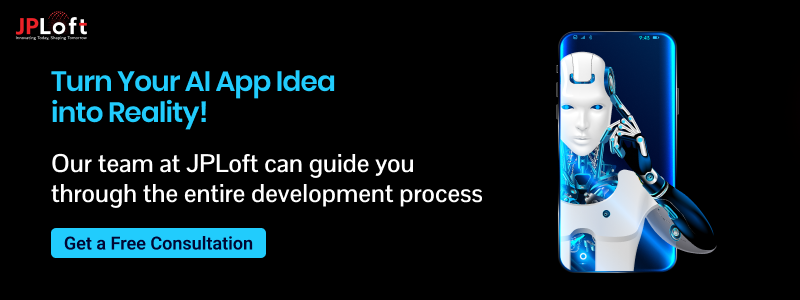
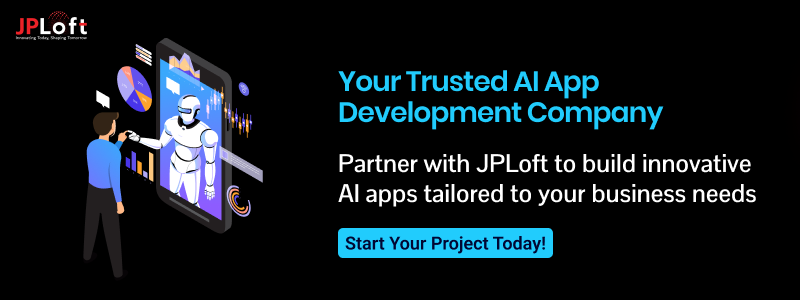
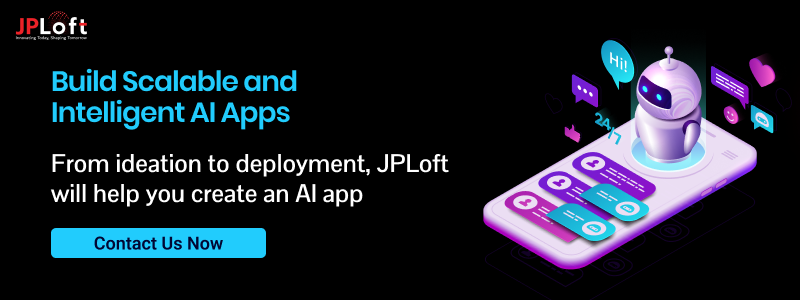

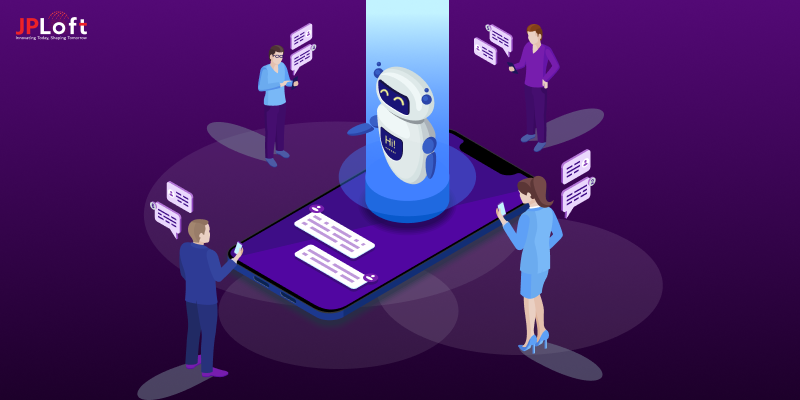
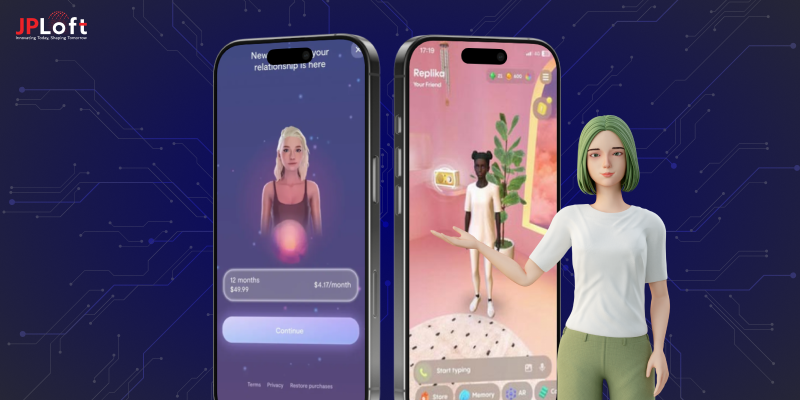




Share this blog